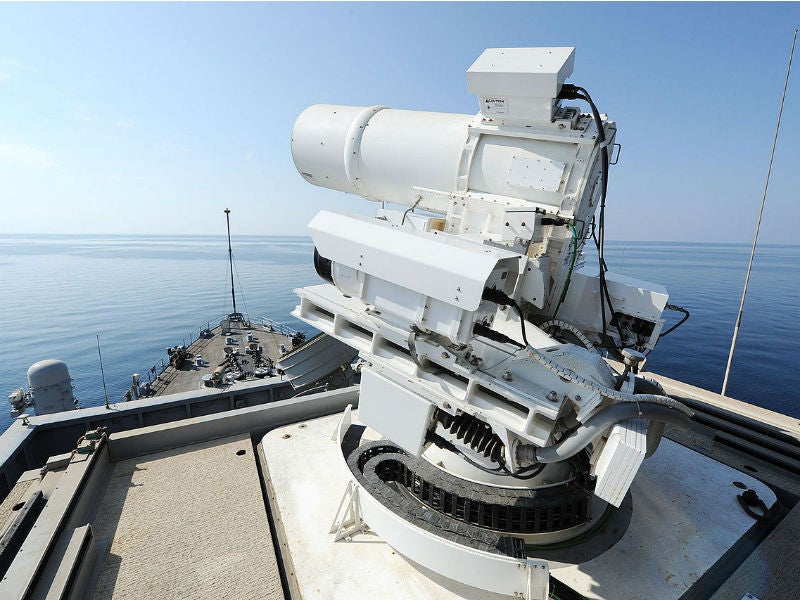
Advancements in Navy Laser Weapon Systems
Across the world, armed forces have been developing navy laser weapon systems to use in battle. For example, the US Navy’s HELIOS system has high energy, intelligence and counter-UAV capabilities; while Russia claims its Filin 5P-42 can disorientate an enemy and induce vomiting.
What are the top navy laser weapon systems, why are they unique and how far are we from seeing them in maritime battles?
Lockheed Martin’s HELIOS

Lockheed Martin reported it is pushing ahead with its efforts to deliver two High-Energy Laser and Intergrated Optical-Dazzler with Surveillance (HELIOS) systems to the US Navy in 2020.
HELIOS poses a triple threat. It is first and foremost a HEL weapon, which can be used to eliminate threats from unmanned aerial systems (UAS) and small boats. Meanwhile, the long-range intelligence, surveillance and reconnaissance (ISR) capability uses sensors to provide combatants with real-time information for maximum strategic effect. Finally, the HELIOS drone dazzler can block or obscure the ability of UAS-based ISR activities.
“The HELIOS programme is the first of its kind, and brings together laser weapon, long-range ISR and counter-UAS capabilities, dramatically increasing the situational awareness and layered defence options available to the US Navy,” said Lockheed Martin vice president and general manager of integrated warfare systems and sensors Michele Evans.
“This is a true system of capabilities, and we’re honoured the navy trusted Lockheed Martin to be a part of fielding these robust systems to the fleet.”
The delivery of the first two HELIOS systems will cost $150m plus options worth up to $942.8m.
Ruselectronics’ 5P-42 Filin

Next on the list of top navy laser weapon systems is Russia’s 5P-42 Filin system developed by state-owned company Ruselectronics.
The capability claims of the 5P-42 Filin are both remarkable and terrifying. The 5P-42 Filin, while it is non-lethal, has the ability to disorientate an enemy through visual-optical interference, to the point where the enemy could suffer from hallucinations and vomiting.
Rostec industrial director Sergey Abramov said [translated from Russian]: “When conducting special operations, the opportunity to blind the enemy gives a significant tactical advantage. This makes it impossible for intruders to conduct aimed fire or monitor the movement of combat units.”
Using high-intensity light radiation, the Filin can temporarily blind the enemy. By constantly changing the frequency of light, the system will affect combatants’ optic nerves and cause temporary eye disorders, including hallucination. This capability is currently effective at a range of 500-700m.
Kratos’s AN/SEQ-4 LaWS
The AN/SEQ-4 Laser Weapon System built by Kratos and developed by the US Naval Research Lab is a directed-energy weapon.
Initial testing of the LaWS, which cost around $40m to develop, saw the system successfully destroy two small metal targets on floating platforms, as well as a target drone. The US Navy then deployed the system on the USS Ponce, integrating it with the vessel’s Phalanx, which uses a radar tracking system for laser targeting and guidance.
The infrared beam from a solid-state laser array can be tuned from high output to low output. At high output (around 30kW), the laser can destroy targets, fry sensors, burn out motors and detonate explosive material. At low output, the LaWS system can dazzle enemy combatants and cause them to turn away from threatening positions.
Furthermore, the LaWS can shoot down small UAVs in two seconds and can destroy motors on small boats, thus disabling them and mitigating the threat. A significant advantage of the laser over projectiles is the low cost per shot.
MBDA’s Dragonfire

MBDA’s e Dragonfire is a UK-built laser directed energy weapon currently being developed by the Defence, Science and Technology Laboratory (Dstl) on behalf of the Ministry of Defence (MOD), under a £30m contract award.
The MOD said that a new laser weapon could be used to complement or replace existing weapons systems, and be used to protect maritime forces, “for example, ships from threat missiles or soldiers from enemy mortars”.
“Dragonfire is the culmination of many years of work in the area of laser directed energy weapons,” said Dstl project technical authority for Dragonfire Peter Cooper.
“We are looking forward to the 2019 demonstration and, working with our industry colleagues, we aim provide the UK Armed Forces with innovative, effective and affordable solutions to the emerging threats they face.”
Benefits of the Dragonfire laser weapon include affordability, precision and adaptability to existing technology, such as Leonardo’s beam director.
Elbit’s Elop maritime laser

Elbit developed its advanced navy laser weapon systems following a merger with Electro-optics (Elop). It can identify the range of a target at high repetition rates, which is critical for enhancing the efficiency of naval weapons systems.
Elop general manager Adi Dar told Photonics Media: “The increasing demand for advanced laser systems, specifically miniaturised designators, is due to their ability to perform with high precision and prevent collateral damage. Our advanced laser solutions, including our miniaturised Rattler designator for small airborne and ground applications, have enabled bringing precision targeting to use on a wider scale.”
Elop’s eye-safe high repetition range-finders can be added to existing systems in a cost-efficient manner, or be added to new systems. To achieve a high repetition rate, the naval compact integrated laser uses diode-pumped solid state laser (DPSSL) technology. While the beam quality is higher using DPSSLs over traditional diode lasers, they are less considered as more expensive and less efficient.



